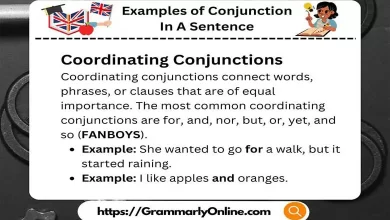10 Examples of Coordinating Conjunctions
Coordinating conjunctions are essential elements in English grammar that help connect words, phrases, or clauses of equal rank. These conjunctions are pivotal in creating complex and sophisticated sentences, thus enriching the quality of written and spoken language. In this article, we will delve into ten examples of coordinating conjunctions, examining their functions, and usage, and providing detailed examples to ensure a thorough understanding.
1. The Importance of Coordinating Conjunctions
Coordinating conjunctions, often remembered by the acronym FANBOYS, are: for, and, nor, but, or, yet, so. These words play a crucial role in linking words, phrases, or clauses that are of equal importance in a sentence. They are instrumental in avoiding choppy sentences and creating a more natural flow in writing and speech.
2. For: Expressing Reason
The coordinating conjunction “for” is used to explain reasons or purposes. It connects two ideas by showing a cause-and-effect relationship.
Example:
- She decided to go to bed early, for she was very tired after a long day at work.
In this example, “for” links the reason for her decision to go to bed early.
3. And: Adding Information
“And” is perhaps the most common coordinating conjunction. It is used to add one idea to another, indicating a continuation or addition of the same idea.
Example:
- They went to the park and played soccer until sunset.
Here, “and” connects two activities, emphasizing that both happened together.
4. Nor: Presenting a Negative Option
The conjunction “nor” is used to introduce an alternative negative idea to an already stated negative idea. It is often paired with neither.
Example:
- She didn’t like the movie, nor did she enjoy the book it was based on.
“Nor” connects two negative statements, enhancing the emphasis on her dislike.
5. But: Showing Contrast
“But” is used to introduce a contrast or an exception. It connects two opposing ideas, highlighting the difference between them.
Example:
- He wanted to buy the car, but he didn’t have enough money.
“But” here contrasts his desire to buy the car with his financial situation.
6. Or: Offering Choices
The coordinating conjunction “or” is used to present alternatives or choices. It is essential in making decisions and presenting different possibilities.
Example:
- Would you prefer tea or coffee?
“Or” here provides a choice between two beverages.
7. Yet: Introducing an Unexpected Outcome
“Yet” is used to introduce a surprising or unexpected outcome, showing a contrast with what was expected.
Example:
- She is very young, yet she has achieved so much in her career.
“Yet” emphasizes the surprising nature of her achievements despite her young age.
8. So: Indicating a Result
The conjunction “so” is used to show the result or consequence of an action.
Example:
- It started raining, so we decided to stay indoors.
“So” connects the cause (it started raining) with the effect (we decided to stay indoors).
9. Combining Multiple Coordinating Conjunctions
In more complex sentences, multiple coordinating conjunctions can be used to link various ideas. This creates intricate sentences that convey detailed and layered information.
Example:
- She wanted to go for a walk, but it was raining, so she stayed home and read a book.
This sentence uses “but” and “so” to connect different ideas and show the progression of events.
10. Coordinating Conjunctions in Complex Sentences
Coordinating conjunctions can also be used to link independent clauses in complex sentences, enhancing the depth and richness of the text.
Example:
- The team played well, yet they did not win the match, and the fans were disappointed.
This sentence uses “yet” and “and” to link three independent clauses, providing a comprehensive view of the situation.
Practical Usage Tips
When using coordinating conjunctions, it is crucial to ensure that the connected elements are of equal grammatical rank. This means that the conjunctions should link either two nouns, two phrases, or two clauses, but not a mixture. Proper punctuation is also important; a comma is often required before the conjunction when connecting two independent clauses.
1. Avoiding Run-On Sentences
While coordinating conjunctions help in creating complex sentences, overusing them without proper punctuation can lead to run-on sentences. It is vital to use commas and periods appropriately to maintain clarity and readability.
2. Maintaining Parallel Structure
When using coordinating conjunctions, it is important to maintain parallel structure. This means that the elements being connected should follow the same grammatical form. For example:
Correct:
- She enjoys reading and writing.
Incorrect:
- She enjoys reading and to write.
Ensuring parallel structure enhances the readability and coherence of the sentence.
3. Enhancing Writing Style
Using a variety of coordinating conjunctions can enhance writing style by adding complexity and nuance to sentences. Instead of relying solely on “and,” incorporating other conjunctions like “but,” “or,” and “yet” can make the writing more dynamic and interesting.
4. Practicing with Examples
Practice using coordinating conjunctions in different sentences to become more comfortable with their usage. Writing exercises that focus on combining sentences using coordinating conjunctions can be particularly beneficial.
5. Analyzing Professional Writing
Reading and analyzing professional writing can provide insights into effective use of coordinating conjunctions. Pay attention to how authors connect ideas and create flow in their writing, and try to emulate those techniques in your work.
Conclusion
Coordinating conjunctions are powerful tools in the English language that help in connecting ideas and creating complex sentences. By understanding their functions and practicing their usage, one can enhance both their writing and speaking skills. Remember to maintain a parallel structure, use proper punctuation, and vary your conjunctions to keep your writing engaging and coherent.

